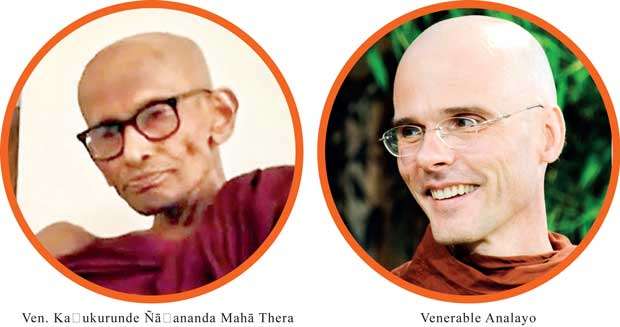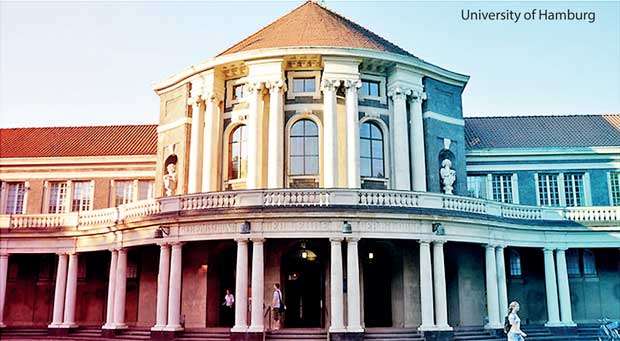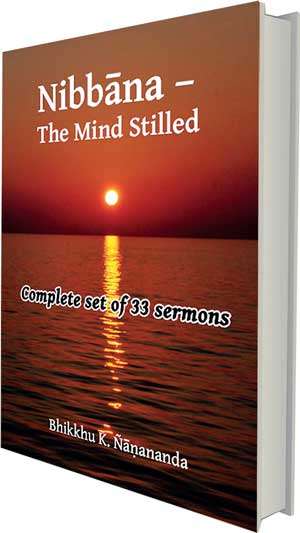Reply To:
Name - Reply Comment
Last Updated : 2024-04-24 08:14:00
Interview with German-born scholar monk Bhikkhu Analayo
While in yesterday’s interview the most Venerable Uda Eriyagama Dhammajīva shared memories of his monastic life with the late Most Venerable Kaṭukurunde Ñāṇananda Mahāthera, today we present the interview of another disciple of the Mahathera, Venerable Anālayo, a German-born bhikkhu.
The Venerable Analayo was ordained in Sri Lanka 23 years ago (1995) under the late Ven. Balangoda Ānanda Maitreya Mahāthera. He completed a PhD thesis on the Satipaṭṭhāna-sutta at the University of Peradeniya (published by Windhorse in the UK) and a Habilitation research at the University of Marburg, Germany in which he compared the Majjhima-nikāya Discourses (Suttas) with their Chinese, Sanskrit and Tibetan counterparts.

At present, Bhikkhu Anālayo is a professor at the University of Hamburg, the co-director of the Āgama Research Group at the Dharma Drum Institute of Liberal Arts (Taiwan), and a core faculty member of the Barre Center for Buddhist Studies (Mass., USA). The venerable spends five days a week on solitary retreat, and dedicates the weekend to translations, research work and teaching. He has been instrumental in bringing the late Ven. Kaṭukurunde Ñāṇananda Mahāthera’s teachings to a larger audience, notably in English-speaking academia and the Western Dhamma scene.
Excerpts:
QCould you recount how you came to know about Ven. Katukurunde Ñanananda and then went on to meet him?
As I remember it, the first time we met he had come to the Lewella Meditation Centre – a small meditation centre at the outskirts of Kandy that I was in charge of. He had been brought there by Mr. Mapa, his chief disciple- and at that time the Public Trustee of Sri Lanka, later the Ambassador of Sri Lanka to Myanmar. Ven. Kaṭukurunde Ñāṇananda was on a casual visit to the place and doing a little sightseeing. So I think that was the first time we met in person, although I had of course already heard about him and knew about his ‘Concept and Reality’.
 I believe, not too long after that, he had made an English translation of the first of his famous Nibbāna Sermons given originally in Sinhala at Meetirigala Nissaraṇa Vanaya. He had done that just on a cassette tape and given it to, I think, Mr. Mapa. Mr. Mapa had then passed it on to Godwin Samararatne, or may be Ven. Ñāṇananda gave it directly to Godwin, I don’t know. But through Godwin from Nilambe Meditation Center, who was my kalyāṇamitta, I came to hear this English translation of the first of these thirty-three Nibbāna Sermons. I was electrified. I had never come across such clear and profound teachings and expositions on the PaliSuttas. It might have been on the same day, or immediately afterwards, I went there right away. He was staying in Kegalle, living in a cave. I said “Bhante, you just keep translating, I do all the rest. I will type it out and do whatever needs to be done”.
I believe, not too long after that, he had made an English translation of the first of his famous Nibbāna Sermons given originally in Sinhala at Meetirigala Nissaraṇa Vanaya. He had done that just on a cassette tape and given it to, I think, Mr. Mapa. Mr. Mapa had then passed it on to Godwin Samararatne, or may be Ven. Ñāṇananda gave it directly to Godwin, I don’t know. But through Godwin from Nilambe Meditation Center, who was my kalyāṇamitta, I came to hear this English translation of the first of these thirty-three Nibbāna Sermons. I was electrified. I had never come across such clear and profound teachings and expositions on the PaliSuttas. It might have been on the same day, or immediately afterwards, I went there right away. He was staying in Kegalle, living in a cave. I said “Bhante, you just keep translating, I do all the rest. I will type it out and do whatever needs to be done”.
And so from then on, for the next, I believe, ten years, the venerable would in his cave translate his own Sermons from Sinhala into English and record them on a cassette tape. I would then get this cassette tape, sit there at the Lewella Meditation Center and transcribe them. I would also find all the references – because I had a computer, and at that time the Pali Canon had been already digitalized. So it was fairly easy to type in the Pali text and search. His Pali pronunciation was very clear, and I could find all the references and then provide all the annotation required to direct the reader to the Pali Text Society edition of the Pali passages Ven. Ñāṇananda was quoting in the Sermons. And so in relation to this transcribing and annotation work I would go to visit him, may be every two to three months, taking the occasion to ask all the thousand and one questions that I might have had in relation to the sermons or other parts of the PaliSuttas. He was always very obliging to discuss and explain things to me. Together with Ven. Bhikkhu Bodhi, Ven. Kaṭukurunde Ñāṇananda has been my second main teacher; I consider these two bhikkhus to have laid the foundation to all my work.

Q What would you say is the single most important point of Dhamma that was clarified or transmitted to you by the Maha Thera?
I think the single most important point – which is a little bit difficult to identify because I have learned so much from him – is his relentless emphasis on Nibbāna. He clarifies in what way all the different teachings eventually point to one thing, the total liberation from all defilements and destruction of craving which is Nibbāna.
Q How has the encounter with the Mahāthera inspired your life and practice as a scholarly and meditating monk?
I think I have answered that question a little bit already. Bhikkhu Kaṭukurunde Ñāṇananda and Bhikkhu Bodhi, together, have been the two most important influences in my life as a monastic and in particular in understanding the PaliSuttas. Ven. Ñāṇananda has also deeply inspired my meditation practice. Not so much in the sense of actual meditation instructions – the practice that was being followed there at Kegalle by him and the disciples who were living there with him, was not the practice I was following at that time – but, much rather, in terms of taking the Discourses seriously, taking seriously what they have to offer, looking at them in their own right and through the lens of later tradition.
With all due respect to the Commentaries and later scholastic works, which have no doubt made very important contributions to our understanding and practice, and certainly are closer to the time and world of the original delivery of the Discourses than we are, it is refreshing to be able to set them aside for the time being in order to create space and look at the Discourses in their own right. What do the Pali Discourses have to say on central meditation practices? What do they have to offer us for understanding the deep aspects of the Dhamma? I think this is probably the most important impact the venerable had on me. Certainly neither the venerable nor I would advocate a sort of Sutta or Early Buddhism fundamentalism wherein the Theravāda tradition is rejected; it is more a matter of treading a middle path between complete reliance on textual orthodoxy and complete reliance on personal opinions and the potential arrogance of subjectivity.
But I have to also say that the transcribing of the Nibbāna Sermons – you know, when you transcribe you listen again and again – has been in a way a guided meditation of some sort for me. I listened and relistened to these sermons, and caught finer points on certain aspects that he pointed out. Because of his own relentless emphasis on Nibbāna, this always in some way or the other influences my own practice.
Q You have recently started an e-learning programme on the Nibbāna Sermons at the University of Hamburg – one of the most prestigious institutions for the study of Buddhism in the West – in collaboration with the Barre Center for Buddhist Studies –which is in turn the oldest centre for insight practice in the United States. How do you present the Sermons? What kind of students are participating in the course?
 The main purpose of presenting the Nibbāna Sermons at these two very well-known and influential places, the Numata Center for Buddhist Studies of the University of Hamburg in Germany and the Barre Center for Buddhist Studies in Massachusetts in the USA, was primarily to draw more attention to them.
The main purpose of presenting the Nibbāna Sermons at these two very well-known and influential places, the Numata Center for Buddhist Studies of the University of Hamburg in Germany and the Barre Center for Buddhist Studies in Massachusetts in the USA, was primarily to draw more attention to them.
So I thought doing an online course which would draw more attention to them, and the advantage is that as a university online course there is no charge, it’s all free, and so it preserves the venerable’s spirit of not wanting any kind of selling or buying to be associated with his teachings, but at the same time it makes them stand out much more prominently than free-distributed publications that are not always readily available outside certain circles. And it makes them more noticeable internationally by people who have earlier maybe not even heard of him, let alone of his sermons. We did this in three years. We did Sermons numbering 1 to 11 last year and just now we are doing from 12 to 22, and then the rest, the final eleven, will be done next year.
We go through the Sermons and I sometimes provide additional comments on them, in particular from my own area of expertise, which is the comparative study of the Early Buddhist Discourses. In addition to the Pali Discourses we also have the final products of the same type of oral transmission preserved in other languages, such as Chinese, Sanskrit and Tibetan. This is my own area of study and research, particularly comparing the PaliSuttas with their parallels in the Chinese Āgamas (the counterparts to the PaliNikāyas), which can often help us to identify some passages that might have suffered from transmission errors in one way or the other during the course of the textual transmission, or to clarify knotty passages. I usually point out what the perspective is based on such parallels.
The students who are participating in the course are foremost, of course, those at the University of Hamburg or enrolled in similar Buddhist Studies programs in other universities worldwide. But there are also quite a number of meditators and Dhamma-practitioners who have heard of these online classes. Last year we had over 600 students enrolled in the course – not all of them of course coming to the virtual classroom to listen to every single lecture, but there is a very lively online dialogue in the discussion forum. And at this forum there is an exchange between participants focusing on both doctrinal and practice-oriented, contemplative topics related to each sermon. Usually at the beginning of each lecture I take up a few of those comments. At the end of the course, the lectures are freely available online, so that anybody who has not been able to enroll in the course could still follow the presentation at whatever time the individual finds suitable.
I believe that this attempt to give more emphasis and wider publicity to the Nibbāna Sermons has been very successful and I really hope that these powerful teachings by Ven. Ñāṇananda would continue to inspire other practitioners and students of Buddha Dhamma in the world.
Steve Sunday, 13 May 2018 02:34 AM
Wondering if you can provide a link to the discussion forum mentioned? Thanks
Mike Wednesday, 06 June 2018 04:33 PM
The lectures are available here: https://analayo2018.buddhistinquiry.org/

Add comment
Comments will be edited (grammar, spelling and slang) and authorized at the discretion of Daily Mirror online. The website also has the right not to publish selected comments.
Reply To:
Name - Reply Comment
US authorities are currently reviewing the manifest of every cargo aboard MV
On March 26, a couple arriving from Thailand was arrested with 88 live animal
According to villagers from Naula-Moragolla out of 105 families 80 can afford
Is the situation in Sri Lanka so grim that locals harbour hope that they coul